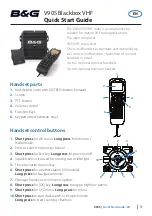
Your Dual Link DVI Optical Transmitter/ Receiver
3
To achieve the best performance:
Connect only good quality connection cables, thus avoiding interference,
deterioration in signal quality due to poor matching, and elevated noise-
levels (often associated with low quality cables)
Avoid interference from neighboring electrical appliances and position your
Kramer
622R
and
622T
away from moisture, excessive sunlight and dust
3.1 Power Connect Feature
The Power Connect feature lets you power a transmitter / receiver system by
connecting just one power adapter to either the transmitter or the receiver. The
other unit is fed over the same CAT5 cable.
The Power Connect feature applies as long as the CAT5 cable is heavy gauge
cable (that is, it can carry power). The distance does not exceed 50 meters on
standard cable.
For a distance of 100 meters, separate power supplies must be connected to the
transmitter and to the receiver simultaneously, unless using heavy gauge CAT5
cable.
3.2 Shielded Twisted Pair (STP) / Unshielded Twisted Pair (UTP)
The decision whether to use shielded twisted pair (STP) cable or unshielded
twisted pair (UTP) cable depends on the nature of the application.
It is recommended that in applications with high interference, shielded twisted
pair (STP) cable will give better results. However, the shield itself does create a
capacitance that degrades the frequency response of the machines. For shorter
distances, of 50m or so, shielded twisted pair (STP) cable is preferred because
it provides protection from interference (degradation is non-apparent).
For a long-range application, unshielded twisted pair (UTP) cable is preferred.
However, the unshielded twisted pair (UTP) cable should be installed far away
from electric cables, motors and so on, which are prone to create electrical
interference.
4 Your Dual Link DVI Optical Transmitter/ Receiver
This section defines the Dual Link DVI optical Transmitter / Receiver:
622T
Dual Link DVI Optical Transmitter
(see section 4.1)
622R
Dual Link DVI Optical Receiver
(see section 4.2)































